|









|
Harveyís
Himalayan
Journal:
1995
14 September
Leave
Cumbria
, dropping off the cats at the cattery, and arrive at
Chichester
about 5.00. Sue has been ill
with diarrhoea for two days, not a good start to what we expect will be an
arduous trip. Meet up with Ben
for dinner at The Old Cross, and retire early to our tiny little attic
room at The Ship.
15 September
Woken at 6.00am by the sound of running water.
The roof is leaking, fortunately not onto our travel clothes.
We realise from the stains on the wall that it is not the first
time this roof has leaked, and I complain.
We get an apology, but nothing further, and the receptionist
doesnít seem surprised. Itís
still raining hard, so no leisurely shopping in
Chichester
. In the end we decide to
visit Petworth House, but itís closed.
We drive through
Sussex
in the rain. At the airport we
meet our guide,
Lorraine
. There will be about sixteen
in our party.
16 September
Itís a long flight but we have some legroom, enjoy the Royal Nepal
Airways food, and we both sleep. We
land in
Kathmandu
at dusk, so the views are disappointing. We
have a snack at the Base Camp and go straight to bed.
And straight to sleep.
17 September
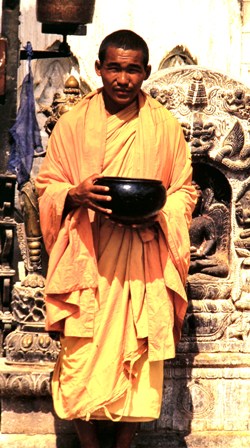 We discover that our hotel, The Himalaya, is actually in Patan, but our
first bus tour is Kathmandu and off we go to the ancient
temple
of
Swayambunath
, perched on a slight hill. Itís
a strange mixture of Buddhism and Hinduism, and the place is seething with
vendors, monkeys, sleeping dogs ~ and even a few monks.
The
stupa is built over Ďthe light of Swambhuí (the self-born), protecting
it until the day when it can once again be allowed to shine on the world.
There is a man dressed in mourning clothes, all in white, making
offerings for a parent who has just died.
In the
temple
Tibetan
monks are sitting in rows, reading from books, some of them (mainly young
boys) chanting the prayers.
We discover that our hotel, The Himalaya, is actually in Patan, but our
first bus tour is Kathmandu and off we go to the ancient
temple
of
Swayambunath
, perched on a slight hill. Itís
a strange mixture of Buddhism and Hinduism, and the place is seething with
vendors, monkeys, sleeping dogs ~ and even a few monks.
The
stupa is built over Ďthe light of Swambhuí (the self-born), protecting
it until the day when it can once again be allowed to shine on the world.
There is a man dressed in mourning clothes, all in white, making
offerings for a parent who has just died.
In the
temple
Tibetan
monks are sitting in rows, reading from books, some of them (mainly young
boys) chanting the prayers.
Then down to the old part of Khatmandu, to
Durbar Square
, where it is dirty and smelly. There
are some beggars, but it doesnít strike us as desperately poor.
Take lots of photos, mainly of street scenes and elaborately-carved
buildings. Would love to take
close-ups of some of the people but havenít the nerve.
There are some wonderful characters about, with holy men in rags
or splendid robes, imposing faces and long beards; women in colourful
saris, many of them arrestingly beautiful; children, some in rags, all looking
bright-eyed. The crowds
are good-humoured and we donít feel threatened, but we have been warned
against pickpockets.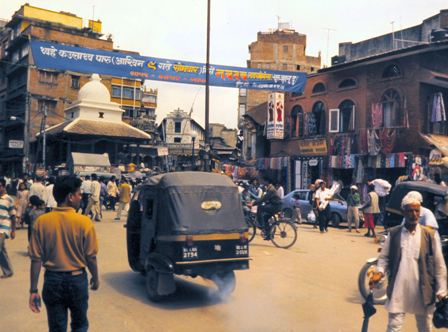
We go to the home of Kumari, the Living Goddess.
There are lots of tourists in the courtyard, and in response to a
shout from one of the guides Kumari appears at one of the open windows.
She allows us to gawp at her for about 5 seconds and withdraws.
She is chosen at the age of 2 or 3 with the aid of astrologers, and
undergoes tests to prove that she is indeed a goddess.
She must be physically perfect, of course, have never shed blood,
and must remain serene when faced with horrifying images.
When we see her she is perhaps eight or nine years old, with heavy
eye make-up and dressed in red and gold.
She only leaves her home two or three times a year to attend
ceremonies. She has a private
tutor (and Michael Jackson videos!) but in the old days Kumari didnít
receive an education. When she
has her first period she will lose her divine status and another little
girl will take her place. An
ex-Kumari must find it difficult to adjust to ordinary life, although she
can marry. At one time it was
thought that a man who married such a girl would die within six months,
and the women had lonely unhappy lives.
Sue seems to be over her diarrhoea but she feels worn out and sleeps in
the afternoon. I walk back to
the bridge over the Bagmati river, the border between Patan and Khatmandu.
There are road works everywhere, and the cocktail of dust and
exhaust fumes is awful. Lots
of people are wearing masks, or holding scarves or hands over nose and
mouth. I come back to the
hotel for a swim and then dry off in the sun, looking across
Kathmandu
to the hills. There is a
rainbow, and then itís raining and I go back to the room.
We have an excellent meal in The Chalet and both feel a bit more
human.
18 September
Sue doesnít join me, but Iím up at 5.45am to take a sight-seeing
flight to Everest. The weather
forecast is not good, but we take off anyway.
Not for long. We hear
that Everest is covered with cloud, and after 15 minutes the flight is
aborted. We come back to the
hotel for breakfast, with a promise that we can try again tomorrow at no
extra charge..
There used to be three major cities in this part of
Nepal
:
Kathmandu
, Patan and Bhaktapur, each with its own
Durbar Square
. Now the cities have run into
each other, forming a vast, sprawling conurbation.
This morning, in the rain, we take a tour of Patan, although it
also seems to be called Lalitpur. We
visit the
Golden
Temple
, dedicated to the god of business. This
seems strange to our western eyes, used to clear divisions between
religion and commerce.
In the afternoon we go to a Tibetan refugee camp, and shed our first tears
of the trip. Probably not the
last. All the workers are
sitting on mats on the floor, and they flash us smiles as we walk through.
We buy two prayer mats at US$29 each and learn our first Tibetan
phrase, Tashi Delek (hello, goodbye, best wishes).
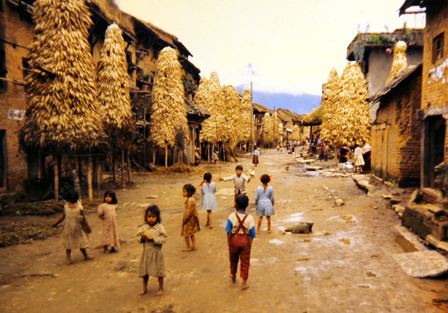 We drive through the suburbs, with modern housing and satellite dishes.
A house with two or three bedrooms costs £200/£300 per month.
We are taken to three country villages, Pharping, Daksinkali and
Chapagaon. The bus stops at
the last one so that we can walk up the main street.
The entire village seems to have turned out for the occasion, and
the children follow us, giggling at the strange sight we must present.
We are equally taken with strange sights; water buffalo being
washed in a pond, old-fashioned corn stooks, and corn cobs hanging out to
dry like alien trees. Also some more familiar
sights: boys playing table tennis, girls skipping.
The whole place feels primitive, from way back in time, but there
is more laughter than we would hear in an English village.
We drive through the suburbs, with modern housing and satellite dishes.
A house with two or three bedrooms costs £200/£300 per month.
We are taken to three country villages, Pharping, Daksinkali and
Chapagaon. The bus stops at
the last one so that we can walk up the main street.
The entire village seems to have turned out for the occasion, and
the children follow us, giggling at the strange sight we must present.
We are equally taken with strange sights; water buffalo being
washed in a pond, old-fashioned corn stooks, and corn cobs hanging out to
dry like alien trees. Also some more familiar
sights: boys playing table tennis, girls skipping.
The whole place feels primitive, from way back in time, but there
is more laughter than we would hear in an English village.
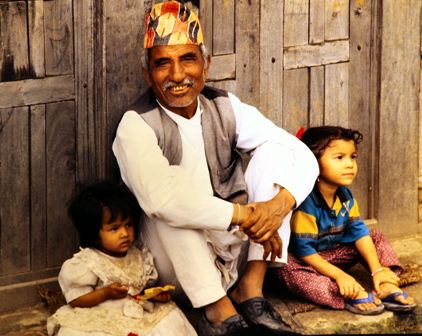
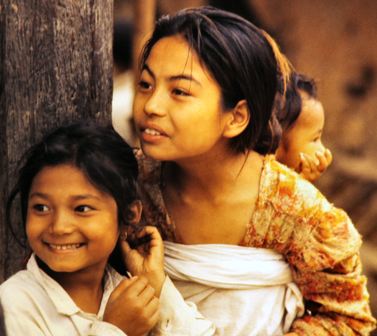
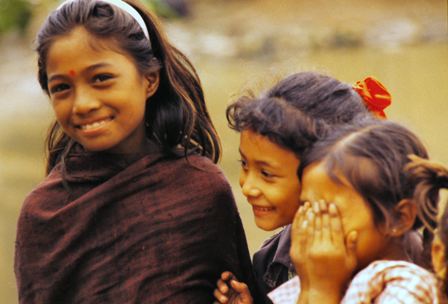
Dinner again at The Chalet, which we enjoy again, but back at the room I
start with diarrhoea. I have
an awful night.
19 September
Feeling really grim, I get up at 5.45 again but I only make it to the
hotel lobby, then rush back to the room to throw up ~ again and again and
again. The flight to Everest
is cancelled again, but I know nothing about this.
By the time we are due to meet the rest of the party in the lobby
to catch the
Lhasa
flight I canít leave the bathroom. Sue
rushes up and down, from lobby to bedroom, trying to work out what happens
now. Fortunately, the
Lhasa
flight is delayed, and I have more time to recover.
We leave a suitcase behind and armed with sick bags I make it to
the airport and survive the flight. Only
just. When the plane lands I
rush to the toilet again. I am
still in there when everyone else (except Sue) has left the plane.
She tries to argue with Chinese soldiers that I need to be left
alone for a few more minutes, but they are suspicious and bang on the
door. I stagger out and down
the steps. By now I am weak
and dehydrated, and we have just landed at 12,000 feet.
We queue for immigration, but I canít stand up and there are no
seats. I sprawl on the floor,
still retching. Sue tries to
request a wheelchair for me, but all she is offered is a baggage trolley.
She declines on my behalf, but when we get through Customs the
guide who meets us has a wheelchair in the bus.
Visiting
Tibet
is a kind of pilgrimage for me, but I didnít prepare for a pilgrimage;
no fasting, no meditating. But
my bodyís reaction to the food and/or pollution in
Kathmandu
did the work for me. Crawling
about on the concrete floor stripped me of my usual impediments ~ ego,
pride and arrogance ~ and I emerge very humbly from the airport weak as a
new-born babe.
We are on a vast plain surrounded by high mountains.
The air is crystal clear, and we canít tell whether the mountains
are near or far. Our guide,
Jetsun, greets each of us with a karta (white silk scarf) as we board the
bus.
It is the traditional Tibetan greeting, a symbol of honesty,
sincerity and loyalty. We
have never before been greeted this way and although we are expecting it, I
shed my first tears in
Tibet
. Someone asks Jetsun what the
Tibetan national flag looks like. ďI
saw one once,Ē she says . . . .
The Chinese have banned anything that might imply that
Tibet
is a separate country. We are
in
China
, in the Tibetan Autonomous Region. Tibet the country only exists in
the minds of the exiles and their supporters.
The journey to
Lhasa
is about one and half hours, and Iím sick again. We
follow a fast-flowing river, passing through villages with prayer flags
fluttering, always surrounded by mountains.
We stop for a photo shoot but I stay on the bus.
At the Holiday
Inn
Sue has to see to everything and I am put to bed.
Around 8.30 a very young-looking female Chinese doctor comes to see
me. She seems to think
it is nothing serious. My
temperature is 37.2 but my heart and blood pressure are OK. She
prescribes pills, although Sue tells her that I wonít be able to keep
them down. We have brought our
own needles for just such an occasion, but Iím given pills.
I canít keep anything in my stomach, not even water (which I now
desperately need). I use an
oxygen pillow and settle into a dull constant nausea.
Eventually I sleep.
20 September
I have stopped vomiting but Sue has started.
We have both had headaches in the night (altitude) and Sueís
turned into acute nausea. Neither
of us wants food but we manage water.
I start to come round and take a much-needed shower, but reading
gives me a headache I am
content to sit and Sue sleeps.
Lorraine
brings us cup-a-soup, which we manage to drink.
We are now drinking water and green tea, so our bodies have
something to work on. By late
afternoon we feel strong enough to walk round the hotel, but we need
frequent rests. We donít
need an excuse to sit and admire one view.
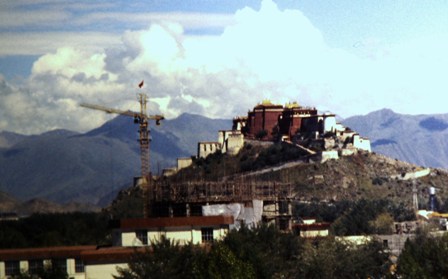 We can see the Potola, the palace of the Dalai Lama, perched
improbably on a hill rising from the middle of the valley floor.
There is a second hill close by, We
know without having to be told that this is Chak Pori, the Iron Mountain,
which once housed the medical monastery, but along with thousands of other
monasteries the Chinese destroyed it.
Now the top of
Iron
Mountain
is graced by communication masts. The
Chinese brought so-called liberation to a backward and feudal people, but
in so doing they destroyed the educational and medical infrastructure run
by the monks. We look at this
very familiar view that we have never seen before and canít believe we
are really here. The Potola
was built for a living god. It
couldnít have been built anywhere else on earth.
We donít have much to show for our first day in
Tibet
, but we feel incredibly moved and privileged to be sharing this
experience. We can see the Potola, the palace of the Dalai Lama, perched
improbably on a hill rising from the middle of the valley floor.
There is a second hill close by, We
know without having to be told that this is Chak Pori, the Iron Mountain,
which once housed the medical monastery, but along with thousands of other
monasteries the Chinese destroyed it.
Now the top of
Iron
Mountain
is graced by communication masts. The
Chinese brought so-called liberation to a backward and feudal people, but
in so doing they destroyed the educational and medical infrastructure run
by the monks. We look at this
very familiar view that we have never seen before and canít believe we
are really here. The Potola
was built for a living god. It
couldnít have been built anywhere else on earth.
We donít have much to show for our first day in
Tibet
, but we feel incredibly moved and privileged to be sharing this
experience.
We
manage a light dinner ~ real food ~ and go to bed.
Already itís hard to remember just how awful I felt only a few
hours ago. Sue is still shaky
and I still have a temperature and a headache.
With altitude sickness itís important to breathe deeply, to get
enough oxygen to the brain. I
am familiar with Buddhist breathing exercises, but as soon as I start to
drift my breathing becomes shallow again, the headache comes back, and I
wake up. I donít get much
sleep, even with the help of the oxygen pillow.
21 September
I use up the last of the oxygen and as soon as I am upright the headache
goes.
We manage some breakfast, and struggle to be ready for todayís trip.
We missed yesterdayís excursion, but we are not going to miss the
Potala. Not if we have to
crawl through its 1,000 rooms. Itís
only a few minutes drive and as the bus waits at the first gate street
vendors cluster round, trying to push their wares through the windows.
The bus takes us up a zigzag path round the back of the Potola, the
tradesmenís entrance presumably, reversing up some of the stretches to
avoid turning tight corners. It
takes us as far as possible up the first few hundred feet, but we still
have a lot of steps ahead of us.
Lorraine
makes sure that we all stop for frequent rests.
Down below we can see the city of
Lhasa
, on a plain that stretches to mountains in the distance.
We are so close to the Potola walls that we canít actually see
much of the building itself. Sue
and I walk slowly hand in hand up the steep paths and into the palace that
we know so well through the books of Lobsang Rampa.
Where would our lives have gone without him?
The rest is a blur. Rooms and
rooms and rooms, corridors and steps, more steps, more corridors.
The steps are more like ladders, and in Lobsangís days they were
greasy with spilt yak butter. Some
of the rooms are vast. There
are statues and murals and ancient books.
There is some electricity, and enormous tubs of yak
butter with lots of wicks, but still it is gloomy, and mostly deserted.
A palace that for centuries had housed thousands of monks is now a
museum. Finally we are
on the roof, looking out over the city and the plain as The Dalai Lama
used to do. And the empty hill top of
Chakpori. 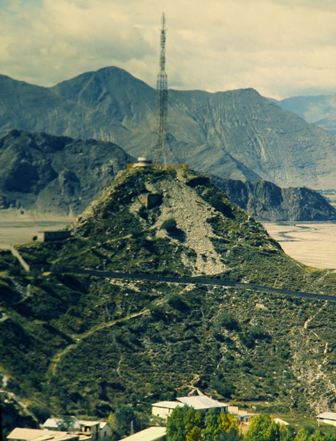 A man is loading a
large burner with juniper twigs. Three
girls sit on top of the walls, repairing them, slapping concrete on with
wooden paddles while they sing. A
puja is taking place in one corner, with drums and trumpets and chanting
monks. Jetsun has an uncle who
is a monk here, and she takes us close, ignoring the Chinese soldier in
mufty who has followed us everywhere. A man is loading a
large burner with juniper twigs. Three
girls sit on top of the walls, repairing them, slapping concrete on with
wooden paddles while they sing. A
puja is taking place in one corner, with drums and trumpets and chanting
monks. Jetsun has an uncle who
is a monk here, and she takes us close, ignoring the Chinese soldier in
mufty who has followed us everywhere.
Our progress has been so slow that we are late leaving.
The rest of the tourists have all gone, and as we go back down
through the palace lights are put out as we leave each room, and doors
shut behind us. It is an eerie
feeling, and yet the whole experience is familiar.
I cannot tell whether I am recognising things from Lobsangís
books or from a previous life. If
it is just from the books he must have been a good writer.
It is only as we return to the bus that we can look back and
finally see the main faÁade of the Potola in all its glory. 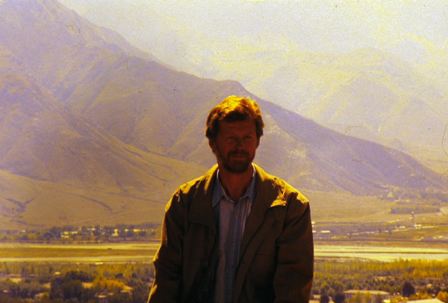
In the afternoon we visit the Norbulingka, the Dalai Lamaís
Summer
Palace
. Every year the people of
Lhasa wore their thick winter clothes until the Dalai Lama made the short
journey to the Norbulingka, signifying that it was officially summer, and
the people could change their clothes.
The gardens are sadly neglected, but the building itself is not too
bad. We donít get to see the
lake. I pick up a leaf from a
Bodhi tree to take to the Head Lama at the Tibetan Monastery in
Cumbria
, unaware until much later that Gesha-la has broken links with the Dalai
Lama.
We see two monks, one with a shaved head, one with long hair.
The long-haired monk has just returned from a solitary retreat, and
needs help adjusting to the outer world again.
There is a guard dog on a roof.
We see a battered old kettle sitting on what looks like a satellite
dish. It comes to a boil with
the heat of the sun, reflected and focused by the metal dish.
Solar power, Tibetan-style. We
buy T-shirts emblazoned with the Tibetan characters of Om Mani Padme Hum.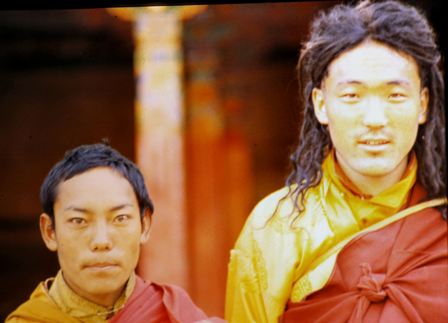
Inside the palace there is a strange mixture of east and west.
There is a radiogram, a present from Nehru; a picture of kittens
from
London
. In one room a monk is
chanting and drumming, and we sit for a few minutes, but itís not
enough. It doesnít feel
alive. We walk through
the Dalai Lamaís private apartments and audience rooms, with a beautiful
gold & silver throne.
When a monk is Ďoff dutyí he might leave his spare robe on his prayer
mat, folded into a conical shape, awaiting his return.
The Dalai Lamaís robe sits on his throne, awaiting his return
from exile. There is an
enormous mural, showing the history of all the Dalai Lamas. The
mural is unfinished. The last
event depicted is the visit of the Fourteenth to
Beijing
in 1954. ďAnd thatís the
end of the story,Ē says Jetsun, almost apologetically.
ďPerhaps itís not the end,Ē I say to her, more in hope than
expectation.
It has been an amazing day. We
are light-headed from our sickness, light-headed from the altitude, and
the experience is almost hallucinatory.
It is not that we have fulfilled a life-long dream; when we read
Lobsang in our teens
Tibet
seemed as remote as the moon. They
used to say, see
Naples
and die. For
Naples
read
Lhasa
.
We both eat a good dinner. Sue
reckons this thin, dry air suits her.
Then we pack rucksacks ready for an early start in the morning.
We have left one suitcase in
Kathmandu
; we will leave our second at the Holiday Inn.
As with all good pilgrimages, we shed burdens along the way, and
tomorrow we will travel light. Again,
I donít sleep well.
22 September
We have an eight-hour drive ahead of us, but we set off late.
One of our party is suffering so much from altitude sickness that
Lorraine
has to arrange for her and her husband to fly back to
Kathmandu
. Itís 9.30 when we leave,
with a rucksack each and a few carrier bags.
We head west, back towards the airport, but soon turn off this road, over
a bridge, and say goodbye to tarmac. The
bus climbs up this rough, pot-holed road passing masses of wild flowers,
mostly blue and purple, to the
Kampala
Pass
at 5,000 metres. We stop for
photos, looking down at the villages by the river on the plateau below.
There are yaks, being watched by two girls.
The 12-year old is responsible for 7 animals; the younger girl has
4. Traditionally,
girls are sent out as yak-herders from the age of 6, and they are out from
dawn Ďtil dusk. They fire
stones from slings to keep the yaks under control.
The girls are too shy to show us, but our driver demonstrates.
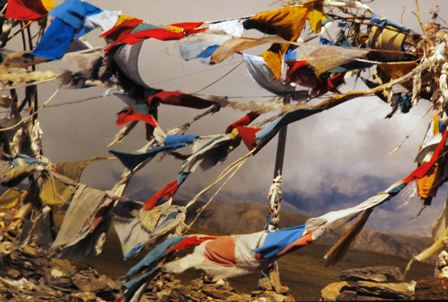 Prayer-flags mark the highest point of the pass, and we are now looking
down the other side of the mountain at a sacred lake, Yamdok Yuntso.
It seems quite narrow, but stretches as far as we can see in either
direction, an amazing shade of blue, like the
Aegean
. There are mountains
everywhere, some snow-capped. The
bus takes us down to the lake and we drive along side it, stopping for a
picnic on the shingle beach. It
is our first taste of yak meat. Surprisingly,
it is tasty and tender. There
are vast herds of sheep and goats on the beach, although there doesnít
seem much for them to eat. The
herd boys, and other hangers-on, are keen to take our leftovers, so
perhaps that is why the animals are not enjoying green pasture higher up.
Prayer-flags mark the highest point of the pass, and we are now looking
down the other side of the mountain at a sacred lake, Yamdok Yuntso.
It seems quite narrow, but stretches as far as we can see in either
direction, an amazing shade of blue, like the
Aegean
. There are mountains
everywhere, some snow-capped. The
bus takes us down to the lake and we drive along side it, stopping for a
picnic on the shingle beach. It
is our first taste of yak meat. Surprisingly,
it is tasty and tender. There
are vast herds of sheep and goats on the beach, although there doesnít
seem much for them to eat. The
herd boys, and other hangers-on, are keen to take our leftovers, so
perhaps that is why the animals are not enjoying green pasture higher up.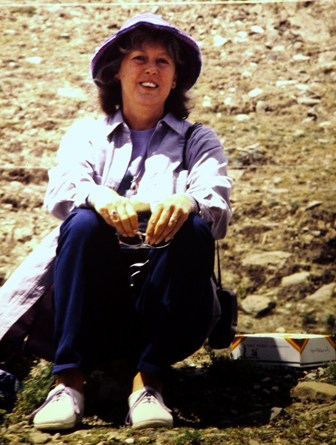
The bus continues its bone-shaking drive by the lake for what seems like
hours, stopping only briefly for toilet breaks.
Gents to the left, ladies to the right, find your own boulder to
hide behind.
Lorraine
calls them pit stops, which Jetsun mis-hears.
She thinks we are stopping for pizza. We climb again to a high
pass. This is the
Karalla
Pass
, at over 5,000 metres. Jetsun
tells us that if we walk up a slight hill we will be able to see a tented
village, at the foot of a glacier. I
can walk up hills in Cumbria, but after a few yards my legs feel like
jelly, I canít breathe, I have a splitting headache, but I get to see
the nomad tents and the glacier. The
nomads rush over to us (no altitude sickness for them) and follow us back
to the bus. The children want
food, and we hand out more leftovers.
Jetsun tells us they would like anything we have left and gives
them our rubbish bag with cardboard containers, bits of string, apple
cores, empty water bottles, half-eaten sandwiches.
The children fight over it.
Nothing is wasted here. The
mothers ask for money.
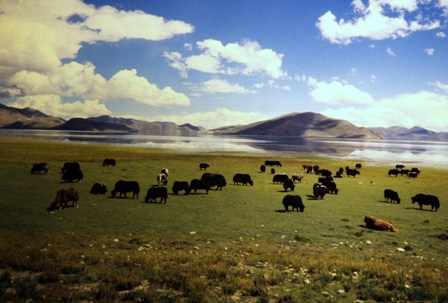 We drive down the other side of the pass, and the bad road gets even
worse. Every few hundred
yards the surface has been washed away, and sometimes we canít imagine
how the bus will make it. On
one occasion a bulldozer is working on a landslide and has to clear a way
for us. The constant jolting
and thin air make for unpleasant travelling.
My headache persists for several hours.
One couple is quite ill but refuse oxygen.
We leave the road and drive through a quarry, a site for a
hydro-electric station. We
donít know whether it is a short-cut or a long diversion.
Eventually, at 7.00pm, we arrive in Gyantse, weary and exhausted.
Our hotel, the Gyantse Hotel, seems grim and Spartan, more like a
barracks. We sit down for a
buffet meal as a party. I
donít eat much. Our room is
very cold but we have snug quilts. Our
bodies still feel o be vibrating. It
has been a dreadful, unbelievable, unmissable day. Sue
sleeps for almost 10 hours.
We drive down the other side of the pass, and the bad road gets even
worse. Every few hundred
yards the surface has been washed away, and sometimes we canít imagine
how the bus will make it. On
one occasion a bulldozer is working on a landslide and has to clear a way
for us. The constant jolting
and thin air make for unpleasant travelling.
My headache persists for several hours.
One couple is quite ill but refuse oxygen.
We leave the road and drive through a quarry, a site for a
hydro-electric station. We
donít know whether it is a short-cut or a long diversion.
Eventually, at 7.00pm, we arrive in Gyantse, weary and exhausted.
Our hotel, the Gyantse Hotel, seems grim and Spartan, more like a
barracks. We sit down for a
buffet meal as a party. I
donít eat much. Our room is
very cold but we have snug quilts. Our
bodies still feel o be vibrating. It
has been a dreadful, unbelievable, unmissable day. Sue
sleeps for almost 10 hours.
23 September
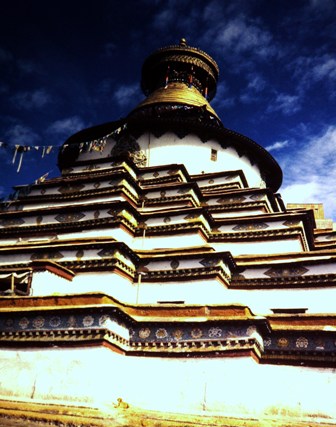 Breakfast not very appetising. I
have rice gruel. Then we visit
the Palchor Monastery. The
courtyard is full of dogs. The
monks are tolerant of them in case they have been monks in previous
incarnations. There are
statues of Buddha and other Bodhisatvas, and grainy copies of photos of
their spiritual leader. We
have been warned against handing out photos of The Dalai Lama; the Chinese
regard him as a splittist and have banned his photos, books and teachings.
This is a living monastery, not a museum, and the monks are
cheerful and joke with us. There
is an octagonal building with a golden dome known as Bakhor Chorten, the
chorten of 100,000 Buddhas. Outside
are huge brass prayer wheels. Inside
are five floors, each with side chapels and rows and rows of Buddha
statues.
Breakfast not very appetising. I
have rice gruel. Then we visit
the Palchor Monastery. The
courtyard is full of dogs. The
monks are tolerant of them in case they have been monks in previous
incarnations. There are
statues of Buddha and other Bodhisatvas, and grainy copies of photos of
their spiritual leader. We
have been warned against handing out photos of The Dalai Lama; the Chinese
regard him as a splittist and have banned his photos, books and teachings.
This is a living monastery, not a museum, and the monks are
cheerful and joke with us. There
is an octagonal building with a golden dome known as Bakhor Chorten, the
chorten of 100,000 Buddhas. Outside
are huge brass prayer wheels. Inside
are five floors, each with side chapels and rows and rows of Buddha
statues.
We are given the chance to walk up to the fortress on Dzong Hill.
Sue canít face the climb and stays to wander the streets of
Gyantse. I plod slowly up,
stopping on the way to photograph the view some nuns sitting in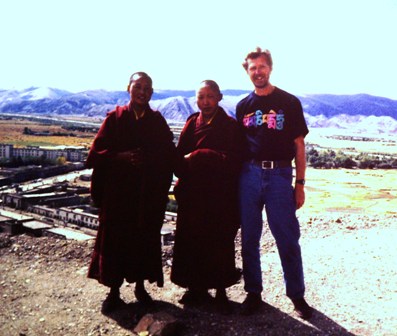 the
foreground. They are wise to
me, and want me to pose them while one of them borrows my camera.
The fortress is famous for an incident in 1903 that as an
Englishman abroad makes me feel uncomfortable.
The British Government thought that Tibet provided a channel
through which China and Russia could attack India and sent an expedition
led by Francis Younghusband to negotiate with the Dalai Lama for a British
legation in Lhasa. Younghusband
was accompanied by over 1,000 armed soldiers.
Not surprisingly, the Tibetans thought they were being invaded and
resisted. Gyantse had a
fortress with artillery, and the British laid siege..
When it became obvious that the Tibetan soldiers could not
withstand the siege many of them threw themselves off the battlements to
their death rather than surrender. Ironically,
on his retreat from
Tibet
, Younghusband had a mystical experience that suffused him with love for
the world and convinced him that man is divine.
He went on to found the World Congress of Faiths. the
foreground. They are wise to
me, and want me to pose them while one of them borrows my camera.
The fortress is famous for an incident in 1903 that as an
Englishman abroad makes me feel uncomfortable.
The British Government thought that Tibet provided a channel
through which China and Russia could attack India and sent an expedition
led by Francis Younghusband to negotiate with the Dalai Lama for a British
legation in Lhasa. Younghusband
was accompanied by over 1,000 armed soldiers.
Not surprisingly, the Tibetans thought they were being invaded and
resisted. Gyantse had a
fortress with artillery, and the British laid siege..
When it became obvious that the Tibetan soldiers could not
withstand the siege many of them threw themselves off the battlements to
their death rather than surrender. Ironically,
on his retreat from
Tibet
, Younghusband had a mystical experience that suffused him with love for
the world and convinced him that man is divine.
He went on to found the World Congress of Faiths.
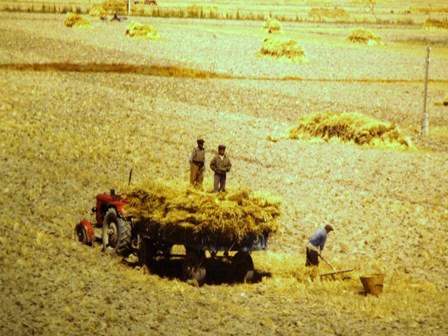 We have lunch back at the hotel and then set off for Shigatse, a two hour
journey which takes three. No
mountain passes this time, we pass fields of ripened corn, and haymaking. We
ask Jetsun about village life and she makes an unscheduled stop to show
us. Sue feels this is
intrusive and doesnít go, but the photographers in the party canít
resist the opportunity. We are
taken to the house of the village headman.
The courtyard walls are covered in pats of yak dung, slapped on to
dry out. The residents do not
seem at all put out by this sudden visit, and we are given an impromptu
tour.
We have lunch back at the hotel and then set off for Shigatse, a two hour
journey which takes three. No
mountain passes this time, we pass fields of ripened corn, and haymaking. We
ask Jetsun about village life and she makes an unscheduled stop to show
us. Sue feels this is
intrusive and doesnít go, but the photographers in the party canít
resist the opportunity. We are
taken to the house of the village headman.
The courtyard walls are covered in pats of yak dung, slapped on to
dry out. The residents do not
seem at all put out by this sudden visit, and we are given an impromptu
tour.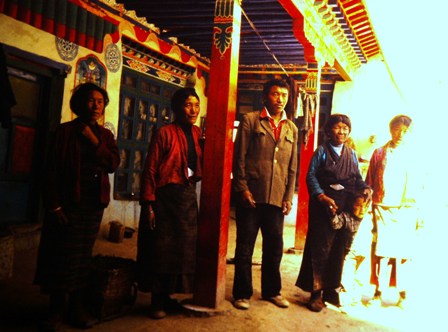
We arrive in Shigatse in time for a short walk round the market before
dinner. The traders are quite
aggressive, clutching and pulling, and some members of the party are
unhappy. Sue doesnít like
the atmosphere. I buy
two carved figures, a man and a woman.
The trader assures me they are carved from yak bone, but it looks
more like plastic. Unwisely, I
reckon that out here yak bone is probably easier to get than plastic, and
it is only later that I see a ridge running down the side of the carvings,
left by the mould. I donít
mind. I feel I am putting some
tourist money into a Tibetanís hands rather than into
Beijing
ís coffers. After dinner we
take another walk, just to look at the light on the mountains.
24 September
Sue has a bad night with diarrhoea and nausea, and has difficulty
breathing. She takes
homeopathic remedies and I get her some oxygen.
She doesnít feel like breakfast (I have rice gruel again) but she
has recovered sufficiently to visit Tashilunpo Monastery.
This is the home of the Panchen Lama, the second highest after the
Dalai Lama, but he also is not in
Tibet
. After the last Panchen Lama
died his next incarnation was recognised and confirmed by the Dalai Lama
in exile. The young boy was
brought to Tashilunpo for training, but Beijing 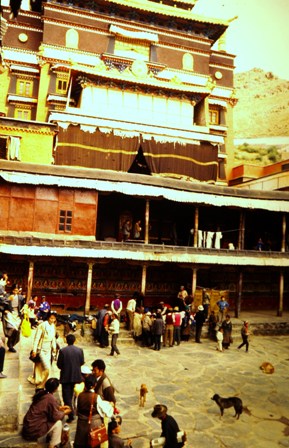 feared a potentially
strong bond between the two high lamas that would attract a following both
within Tibet and in the wider world. They
denounced the boy as an imposter and took him to
Beijing
. He has not been seen since.
The regime in
Beijing
then Ďdiscoveredí the real Panchen Lama and took him under their wing.
A strange move for a communist regime that doesnít believe in
reincarnation, Buddhism, or religion of any kind.
The Chinese nominee had recently visited Shigatse and there had
been trouble, and we had fully expected that we would not be allowed in,
but things had quietened down again. feared a potentially
strong bond between the two high lamas that would attract a following both
within Tibet and in the wider world. They
denounced the boy as an imposter and took him to
Beijing
. He has not been seen since.
The regime in
Beijing
then Ďdiscoveredí the real Panchen Lama and took him under their wing.
A strange move for a communist regime that doesnít believe in
reincarnation, Buddhism, or religion of any kind.
The Chinese nominee had recently visited Shigatse and there had
been trouble, and we had fully expected that we would not be allowed in,
but things had quietened down again.
We are late leaving the hotel. We
assemble in the lobby and hand over our keys but we are kept waiting until
hotel staff check the rooms to make sure that we havenít damaged
anything or smuggled a towel in our rucksacks.
Tashilunpo is worth the wait, a huge monastery more like a village,
built for 5,000 monks. There
are crowds of people, and even though there are only 800 monks now, the
place feels really alive. We
walk across a huge courtyard where the Chinese-selected Panchen Lama
recently addressed the monks and into an assembly room which seats 2,000
monks, the floor crowded with snaking lines of empty cushions.
It is dark and vast, paintings adorning ceiling and walls, it feels
medieval. There is a tomb
stupa for each of the previous Panchen Lamas, and a 26.5 metre statue of
the Maitreya Buddha, the future incarnation, built by the ninth Panchen
Lama. In an inner courtyard what appears to be a jumble sale is
attracting attention.
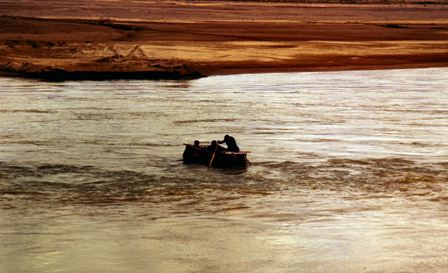 Then we leave Shigatse for the drive back to
Lhasa
, following the Nyang Chu river. We
travel across plains, mostly cultivated, and through wild gorges and
deserts. The road surface is mostly good.
We see a yak-skin coracle making a river crossing, similar to the
one the Dalai Lama used during his escape.
We stop for another picnic, and again there are people waiting for
our leftovers. It takes six
hours to get back to the Holiday Inn.
Sue and I have had quite enough of the rest of the party, and we
have dinner by ourselves in the Hard Yak Cafť.
Then we leave Shigatse for the drive back to
Lhasa
, following the Nyang Chu river. We
travel across plains, mostly cultivated, and through wild gorges and
deserts. The road surface is mostly good.
We see a yak-skin coracle making a river crossing, similar to the
one the Dalai Lama used during his escape.
We stop for another picnic, and again there are people waiting for
our leftovers. It takes six
hours to get back to the Holiday Inn.
Sue and I have had quite enough of the rest of the party, and we
have dinner by ourselves in the Hard Yak Cafť.
25 September
Our 28th wedding anniversary.
Who would have thought it? We
celebrate by joining
Lorraine
, Jetsun and the party on a visit to Drepung Monastery, although Sue has
had another poor night. This
is a large sprawling village of a monastery.
I think Lobsang said its nickname was the rice bowl, because it
looked like a heap of rice spilled onto the mountainside.
This was also destroyed by the Chinese
but belatedly they realised the tourist value of colourful
monasteries and this is in the process of being repaired.
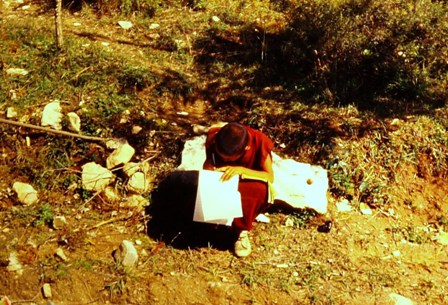 We
notice a small monk sitting by the roadside. He looks as though he
is doing a bit of last-minute homework. In the courtyard, a traditional debate is taking place between young monks.
Part of a monkís education is to learn his subject so well that
he can debate it from either side, and as each monk makes his point he
smacks his hands together. The
exertion is too much for Sue and she goes back to the bus, but I carry on
with the rest of the party through an enormous assembly hall. We
notice a small monk sitting by the roadside. He looks as though he
is doing a bit of last-minute homework. In the courtyard, a traditional debate is taking place between young monks.
Part of a monkís education is to learn his subject so well that
he can debate it from either side, and as each monk makes his point he
smacks his hands together. The
exertion is too much for Sue and she goes back to the bus, but I carry on
with the rest of the party through an enormous assembly hall.
We stop off at a carpet factory on the way back to
Lhasa
. In the bus, Jetsun tells us
some of her experiences. She
is unwilling to talk in public because tour guides are under constant
scrutiny, but on the bus she is safe.
She was sent to
China
for her education, and when she arrived she was teased for being an
unwashed backward Tibetan. When
she returned to
Tibet
she felt she did not know her own country.
She can hardly believe that some of us have seen The Dalai Lama.
We have lunch in our room and then go to the market, where Sue buys 7
scarves and 2 bowls. We leave
the party to do our own thing, we missed the Jokang on the first day and
want to se it before we leave. 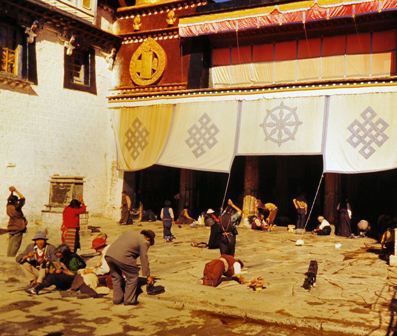 This
is the peopleís monastery, very ancient, the destination of countless
pilgrimages. Some pilgrims do
the last stretch with prostrations. They
lie down, full length, in the dust, stand up, take one step forward, and
repeat the process over and over, hour after hour, sometimes day after
day. Tibetans believe that the
balance between good and evil is only maintained by keeping evil in check.
They see the landscape as a
manifestation of these forces, and the goddess of evil is controlled by
building religious edifices on her strategic body parts, such as her
wrists and ankles. The Jokang
is built on the heart of the goddess. This
is the peopleís monastery, very ancient, the destination of countless
pilgrimages. Some pilgrims do
the last stretch with prostrations. They
lie down, full length, in the dust, stand up, take one step forward, and
repeat the process over and over, hour after hour, sometimes day after
day. Tibetans believe that the
balance between good and evil is only maintained by keeping evil in check.
They see the landscape as a
manifestation of these forces, and the goddess of evil is controlled by
building religious edifices on her strategic body parts, such as her
wrists and ankles. The Jokang
is built on the heart of the goddess.
Inside, the Jokang is almost deserted, and we just glimpse the occasional
monk or pilgrim. Itís our
anniversary and we have the place to ourselves. There are the usual prayer
wheels, religious images and statues, candles, losing their novelty factor
but this place feels very spiritual, very special.
Outside, a storm hits
Lhasa
, and we wander through the dingy rooms with thunder crashing and echoing
all around us. Itís very
eerie. 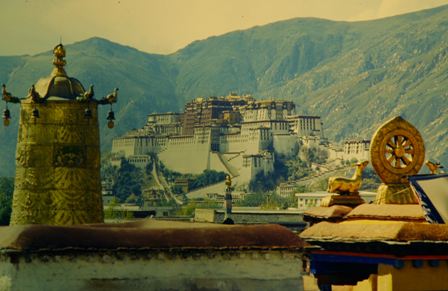 We are not sure where
to go, what we are allowed to do, but eventually we emerge onto the roof
just as the rain stops, with spectacular views of The Potola.
We have to make our own way back to the hotel so we take a rickshaw
ride, costing 20 yuan for 25-minutes.
We stop twice to take photos, and when we get back to the hotel we
ask the driver to take our photo sitting in his rickshaw.
He is delighted, and shares the joke with some of the other drivers
waiting for fares. We are not sure where
to go, what we are allowed to do, but eventually we emerge onto the roof
just as the rain stops, with spectacular views of The Potola.
We have to make our own way back to the hotel so we take a rickshaw
ride, costing 20 yuan for 25-minutes.
We stop twice to take photos, and when we get back to the hotel we
ask the driver to take our photo sitting in his rickshaw.
He is delighted, and shares the joke with some of the other drivers
waiting for fares.
The party is taken to a traditional Tibetan house for dinner, although I
guess this is larger than most Tibetan houses.
This is the real thing, with yak in every course, and although
itís all rather greasy we manage quite well.
I think of the Monty Python spam sketch.
We are offered buttered tea, but I am the only one who drinks it
with any enjoyment.
The experiences of the last few days are stacking up, leaving us almost
reeling, and no doubt we will be months assimilating them, but being on
our own today in the Jokang somehow felt like an affirmation of our
journey together, not just in Tibet but over 30 years, from our Yorkshire
back streets to the top of the world.
26 September
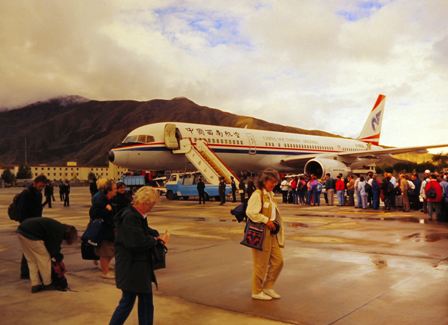 We are woken at 4.45am and leave the hotel at 6.00.
This feels like the end of the holiday.
We have had enough of communal meals and would be happy to go
straight home, but we are flying back to
Nepal
. Somehow, Sue has been
nominated to arrange a collection for Jetsun and the driver.
She makes the presentation with a suitable Buddhist quotation,
although itís probably wasted on most of our party.
We have been surprised at the lack of interest in Buddhism and in
Tibet itself. For most of the
party it was just another country to tick off.
One lady held her handkerchief to her nose whenever we went round a
monastery.
We are woken at 4.45am and leave the hotel at 6.00.
This feels like the end of the holiday.
We have had enough of communal meals and would be happy to go
straight home, but we are flying back to
Nepal
. Somehow, Sue has been
nominated to arrange a collection for Jetsun and the driver.
She makes the presentation with a suitable Buddhist quotation,
although itís probably wasted on most of our party.
We have been surprised at the lack of interest in Buddhism and in
Tibet itself. For most of the
party it was just another country to tick off.
One lady held her handkerchief to her nose whenever we went round a
monastery.
The airport is chaotic, and we queue for an hour before the desk opens for
check-in. Being British, we
are prepared to queue in an orderly fashion, but we get bustled and
jostled by travellers who are not quite so patient.
Lorraine
tries to physically restrain some of them, but she is no match for a
German group. In consequence,
we get the last seats to be allotted, near the back of the plane.
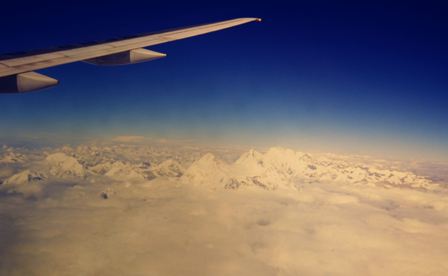 Behind us the plane is empty, and we spread out to take all the
window seats. As we fly past
Everest, with spectacular views, the Germans from up-front plead with us
for a chance to take photographs. The
pilot banks and makes the most of the fly-past for our benefit.
Itís just another mountain, but somehow this is another moving
experience, very humbling. Perhaps
we are just wide open after Tibet, but one of our party sums it up.
ďGod is very close.Ē Behind us the plane is empty, and we spread out to take all the
window seats. As we fly past
Everest, with spectacular views, the Germans from up-front plead with us
for a chance to take photographs. The
pilot banks and makes the most of the fly-past for our benefit.
Itís just another mountain, but somehow this is another moving
experience, very humbling. Perhaps
we are just wide open after Tibet, but one of our party sums it up.
ďGod is very close.Ē
Sue had toyed with the idea of going straight to the Himalaya Hotel just
for two days of peace, but we donít have what it takes to try to make it
happen. Instead, our suitcases
are sent to the hotel and we are taken to Dhulikhel, a mountain retreat.
But this is a tour, and we have more sights to see along the way.
After the thin and clean air of Tibet it is hot and humid.
We have scarcely left Kathmandu airport before we stop at
Pashupatinath. This is a
scared Hindu site on the Bagmati river.
It is a total assault on the senses, with vendors, children and
monkeys all vying for attention. On
the opposite bank there is a temple dedicated to Shiva, with a large
representation of his linga, but we are not allowed there.
Two funerals are taking place, the mourners wailing round the
corpses on their pyres. The
men handle the bodies, infinitely tender, and the women retreat before the
fire is lit, traditionally by the eldest son.
It takes between three and five hours for a body to burn, shorter
for a good person; longer for a bad person.
Then the ashes are swept into the river, where children are
playing, to be carried down river, eventually to reach the
Ganges
. We in the west use the words
Ďin the midst of life there is deathí but we prefer to look the other
way. Here life and death
are closely entwined, and it all seems perfectly natural.
Except for the white people with their cameras.
We have one more stop, at the Bhuddist stupa at Bodnath, with the large
eye of Buddha painted on it. Sue
and I make our circumnambulations, three times in a clockwise direction,
then look at the shops all around.
We arrive at the Dhulikel Mountain Resort Hotel at 1.15, a cluster of red
brick and thatch buildings on a steep hillside looking over green valleys
and ridges to the distant snow-clad summits of the Himalayas.
The Tibetan border is 50 miles away.
Can we see
Tibet
? Who knows.
A border is manís invention, a line on a map.
There is no difference between a mountain in
Tibet
and a mountain in
Nepal
. The hotel has terraced
gardens with ginger lilies and frangipani.
It is beautiful and peaceful. We
should have come straight here from the airport.
We have a huge European lunch, and then the party sets off on a communal
walk. Sue and I head in the
other direction. We are picked
up by several small children who want help with money for their school
books.
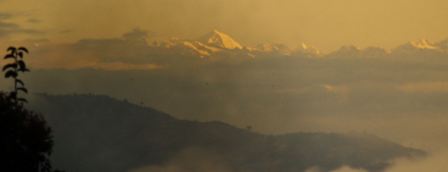 We sit on the terrace with cocktails and watch dusk creeping over the
valleys below. Finally, only
the snowy mountain summits are sunlit, and then they disappear.
We have to be sociable again before and through dinner, European
food again, and canít wait to go to bed.
We sit on the terrace with cocktails and watch dusk creeping over the
valleys below. Finally, only
the snowy mountain summits are sunlit, and then they disappear.
We have to be sociable again before and through dinner, European
food again, and canít wait to go to bed.
27 September
We both sleep well, but I wake early.
I am sitting on the terrace at 6.00am, with orange juice and
coffee, watching the sun rise through the swirling mists.
The Himalayas, those ĎFar Pavilionsí, appear momentarily and
then disappear again. I am
joined by more of the party, who have been up on the ridge for the
sunrise.
We have time for another walk after breakfast, with more small children,
and leave Dhulikel at 11.00 for Bhaktapur, the third of the ancient
triangle of capital cities with Kathmandu and Pathan.
The party is given a quick tour with a local guide, through the
street market, past the pottery where the pots are drying in the sun, past
women spreading grain out to ripen, and then we are
allowed to do our own thing. 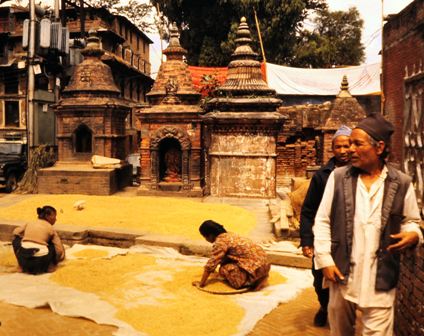 Bhaktapur
is ancient; old, old buildings with incredibly intricate wood carvings.
We go inside one, upstairs, now a cafť, and gawp at the whole of
Nepal passing in front of us down below.
We walk and walk, and shop, and we are picked up by two small boys.
They take us up winding dark alleyways to see the famous
500-yearold Peacock Window, and although we donít encounter any more
tourists we do see local life. Everyone
is friendly. We are told why.
Back in the 1970ís Nepal was on the Hippy Trail, and an
infrastructure developed to keep tens of thousands of tourists happy.
Now tourist numbers are much reduced, and the traders value any
business that comes their way. We
buy a carved turquoise statue, a wooden stupa, a T-shirt, a red dress and
some jewelry. But what we
really want, and didnít find in Tibet, in a thanka with a medical tree.
We donít find it here, either. The boys arrange a taxi for us,
back to the Himalaya Hotel, and we tip them $1 each.
Back at the hotel we have a simple dinner, just the two of us, at
Base Camp. Bhaktapur
is ancient; old, old buildings with incredibly intricate wood carvings.
We go inside one, upstairs, now a cafť, and gawp at the whole of
Nepal passing in front of us down below.
We walk and walk, and shop, and we are picked up by two small boys.
They take us up winding dark alleyways to see the famous
500-yearold Peacock Window, and although we donít encounter any more
tourists we do see local life. Everyone
is friendly. We are told why.
Back in the 1970ís Nepal was on the Hippy Trail, and an
infrastructure developed to keep tens of thousands of tourists happy.
Now tourist numbers are much reduced, and the traders value any
business that comes their way. We
buy a carved turquoise statue, a wooden stupa, a T-shirt, a red dress and
some jewelry. But what we
really want, and didnít find in Tibet, in a thanka with a medical tree.
We donít find it here, either. The boys arrange a taxi for us,
back to the Himalaya Hotel, and we tip them $1 each.
Back at the hotel we have a simple dinner, just the two of us, at
Base Camp.
28 September
The twice-aborted Everest fly-by is called off for the third time, and we
all get our money back ~ even though I didnít even get up to try for
this one. This is our last day
and we have to check out of the hotel, although we donít fly home until
evening. We take a taxi to
Durbar Marg and look round some up-market shops, buying our final
souvenirs, then walk to Thamel, which seems much more touristy.
Lunch at Annapurna Hotel, then a taxi back to Bodnath.
We walk round the stupa again and it comes on to rain.
We take shelter in a shop and strike up a conversation with the
owner. He has just started in
business. He was born in
Darjeeling to Tibetan parents but is now a Nepali citizen.
He has never been to Tibet. Finally, it is time to head for
the airport.
Post Script
I use the word ĎChineseí rather loosely in this journal.
When I talk somewhat critically about
Chinese policy in Tibet I am, of course, referring to the political regime
in Beijing. When travelling in China itself I always found the people just
as friendly as in Tibet.
We had agonised long and hard over making this trip.
Were we playing into the hands of the Chinese, by Ďrewardingí
them for their invasion and occupation of Tibet?
We felt that by showing an interest in Tibetan culture and Buddhist
shrines and monuments we might in some small way be encouraging Beijing to
recognise the value of preservation rather than eradication.
Whilst condemning the brutal Chinese invasion of Tibet, we recognised that
Tibet was perhaps in need of liberating from its old feudal ways.
Fifty years on Beijing had certainly improved roads and some
infrastructure, but the villagers and nomads appeared still to be living
at subsistence level. And yet,
life in the countryside was not dissimilar to life in the countryside in
Guilin or Sczechwan. Beijing
was not singling out Tibet for special treatment; this was simply the
Chinese way.
Ironically, in attempting to wipe out Tibetís feudal ways and
superstitions Beijing had adopted a sledgehammer approach.
When they smashed Tibetan Buddhism the monasteries broke into a
thousand splinters which scattered all over the world.
Tibetan lamas fled over the Himalayas and founded new monasteries
in India, Europe and North America. Tibet
is dead but Tibetan culture is alive and well.
Is there a solution? I think
so. The West is unwilling to
bring pressure to bear on Beijing and so Beijing is unlikely to release
political control of Tibet. But
with encouragement from the international community Beijing could turn
Tibet (or the TAR) into a Spiritual National Park, a Chinese version of
National Heritage status. They
could allow the Dalai Lama to return as spiritual leader in return for the
Dalai Lamaís promise to relinquish all political ambitions.
Beijing could gain international acclaim for such an innovative
move whilst retaining control of Tibetís valuable mineral resources.
Tourists would flock to see this wonder of the world and to spend
their tourist dollars. And the
people of Tibet would have the protection of tomorrowís worldís super
power whilst retaining the freedom to practice Tibetan Buddhism.
I put forward this idea in an article for The Tibetan Journal in
Autumn 1999. But the people of
Tibet are still waiting.
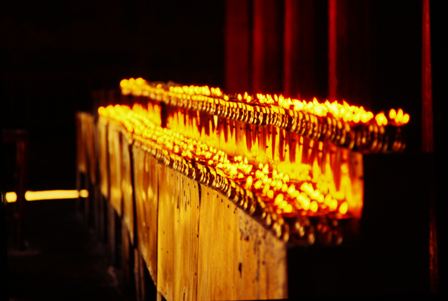
|